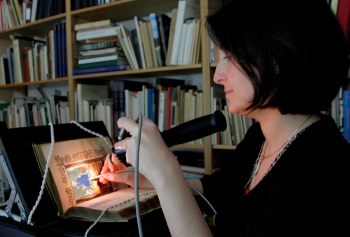Aug 29 2012
Analytik, leading suppliers of innovative analytical instrumentation, report on the use of the ASD portable FieldSpec® 4 spectroradiometer at the Fitzwilliam Museum in Cambridge where the researchers are performing pigment analysis of illuminated manuscripts.
 Dr Paola Ricciardi uses the ASD FieldSpec 4 spectroradiometer at the Fitzwilliam Museum, Cambridge
Dr Paola Ricciardi uses the ASD FieldSpec 4 spectroradiometer at the Fitzwilliam Museum, Cambridge
Dr Paola Ricciardi is a research associate in the Department of Manuscripts and Printed Books at the Fitzwilliam Museum in Cambridge. Her work is part of the MINIARE project, focusing on Manuscript Illumination: Non-Invasive Analysis, Research & Expertise. MINIARE is a new interdisciplinary collaboration between the Fitzwilliam Museum and the University of Cambridge's Departments of Chemistry, Physics, Art History and History and Philosophy of Science. It aims at using a combination of advanced scientific methods for the study of illuminated manuscripts, in order to inform interdisciplinary research and finally provide details of the artistic, cultural, political, social and economic environments in which the manuscripts were created, taking into account trade routes, social and international mobility, intellectual and technological developments. MINIARE brings the sciences, arts and humanities together in Cambridge in unprecedented and exciting ways. The long-term goal is to establish a unique, interdisciplinary research centre that will foster collaboration with research institutions worldwide, training a new generation of scholars that will bridge the divide between the arts and the sciences.
During April and May 2012, Dr Ricciardi and Anuradha Pallipurath (Department of Chemistry) from the MINIARE team used an ASD FieldSpec 4 instrument to characterise both inorganic and organic materials (pigments and binders) on a number of illuminated manuscripts. This spectroradiometer has an extended operating range (350-2500 nm) and this is the key to the success of their work. It is the inclusion of the NIR region (1001-2500 nm) that allows for the analysis of some of the vibrational overtones and band combinations due to functional groups such as hydroxyls, carbonates, and potentially methylenic and amide groups associated with paint binders. For example, one can easily separate green malachite from mixtures of organic yellows and blue azurite. Both being copper carbonates, malachite and azurite are completely indistinguishable by X-ray fluorescence but the latter shows characteristic absorption bands at 1495, 2285, and 2350 nm.
Speaking of the FieldSpec 4 spectroradiometer, Dr Ricciardi said that "the technical specifications including its high sensitivity and high spectral resolution make it the optimal tool to investigate thin and often complex paint layers. The rapidity of acquisition in addition to the instrument's compactness and portability allow surveying a large number of objects directly in exhibition Galleries or storage rooms. It may also yield a substantial comprehensive data set in a short period of time. This allows carrying out large-scale surveys, acquiring spectra on both test panels and works of art, which then can be interpreted and used to both answer some of the art historical questions raised in the initial phase of the research and to inform subsequent phases of the project, during which the characterisation of the materials can be completed, when needed, using supplementary analytical methods such as Raman spectroscopy, XRF, and others."